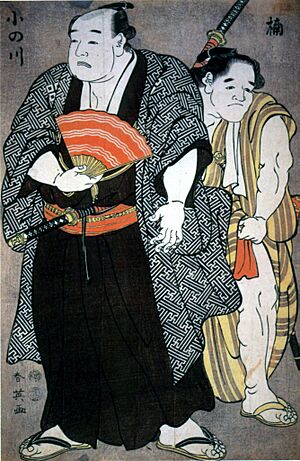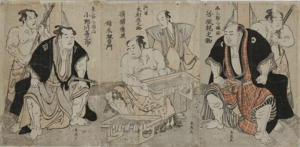Onogawa Kisaburō facts for kids
Quick facts for kids Onogawa Kisaburō |
|
|---|---|
| 小野川喜三郎 | |

19th century woodblock print of Onogawa (left)
|
|
| Personal information | |
| Born | 川村 喜三郎 Kawamura Kisaburō 1758 Ōmi Province, Japan |
| Died | April 30, 1806 (aged 48) |
| Height | 1.76 m (5 ft 9 in) |
| Weight | 116 kg (256 lb) |
| Career | |
| Stable | Kusazuri → Onogawa |
| Record | 144-13-40 4draws-10holds-3no results (Makuuchi) |
| Debut | October, 1779 |
| Highest rank | Yokozuna (November, 1789) |
| Retired | October, 1798 |
| Elder name | Onogawa |
| Championships | 7 (Makuuchi, unofficial) |
| * Up to date as of October 2007. | |
Onogawa Kisaburō (Japanese: 小野川喜三郎, 1758 – April 30, 1806) was a famous Japanese sumo wrestler. He was born in Ōtsu, which is now part of Shiga Prefecture. Onogawa became the 5th yokozuna in sumo history.
He and another great wrestler named Tanikaze were the first to officially receive the yokozuna title while they were still wrestling. Onogawa was a very important figure in sumo during his time.
Contents
Onogawa's Journey in Sumo
Onogawa's real name was Kawamura Kisaburō (川村 喜三郎). When he was 14, he started training in Osaka sumo. His first ring name, or shikona, was Sagamigawa (相模川).
A year later, his master, Onogawa Saisuke, adopted him. He made his sumo debut in May 1772. Later, he changed his ring name to Onogawa Kisaburō. In 1779, he moved to Edo sumo, which is what modern sumo is based on.
Rising Through the Ranks
Onogawa quickly moved up in the sumo world. By March 1781, he reached the top makuuchi division. He started wrestling for the Kurume Domain, a powerful family at the time.
In February 1782, Onogawa achieved a huge victory. He defeated the ōzeki (a high rank) Tanikaze. This was a big shock because Tanikaze had won 63 matches in a row! This amazing match is still remembered as one of the greatest in sumo history.
Rivalry with Tanikaze
Onogawa became a famous rival to Tanikaze. People loved watching them compete. Even though Onogawa was popular, Tanikaze was often stronger. Tanikaze won 21 tournaments, while Onogawa won 7.
In November 1789, both Onogawa and Tanikaze were officially named yokozuna by the Yoshida family. This was a special ceremony where they also introduced the yokozuna dohyō-iri ceremony. This is a special ring-entering ceremony that yokozuna perform. They also wore the yokozuna belt for the first time. This belt was more like a thick rope called a shimenawa back then.
Later Career and Retirement
After becoming yokozuna, Onogawa didn't wrestle in many tournaments. He was getting older and had an injury. In March 1794, he broke his shoulder during training.
His career ended faster when his rival, Tanikaze, suddenly passed away. Onogawa then refused to wrestle against Raiden Tameimon, who was Tanikaze's student and a very strong ōzeki. This meant Raiden had no real rivals for a while.
Onogawa's popularity slowly faded because he wasn't seen in the ring much. He officially retired in October 1797. He had a great record, winning 144 matches and losing only 13. That means he won about 91.7% of his fights! It took another 30 years before the next yokozuna, Ōnomatsu, was named.
After retiring, some stories say Onogawa opened a teahouse in Osaka. Other sources suggest he stayed in Edo as a sumo elder, using his ring name. He passed away on March 12, 1806. His grave is in Osaka.
Interesting Stories About Onogawa
There are some cool stories about Onogawa. One popular tale says he learned jujutsu, a type of martial art, from a famous master named Inugami Gunbei. This happened after the master easily threw Onogawa down twice in a casual match!
Another story tells how Onogawa, after becoming a wrestler for the Kurume domain lord, helped get rid of ghosts that were bothering the lord's land at night. This brave act was even shown in an old Japanese woodblock print by an artist named Yoshitoshi.

Onogawa's Fighting Style
Onogawa was shorter than Tanikaze, standing at 1.76 meters (about 5 feet 9 inches). But he was very fast and had an exciting sumo style that fans loved. This helped him win despite being smaller. People often described Onogawa as a wrestler who stood his ground well. He was careful and smooth in his movements.
See also
- List of yokozuna
- List of past sumo wrestlers
- Glossary of sumo terms

